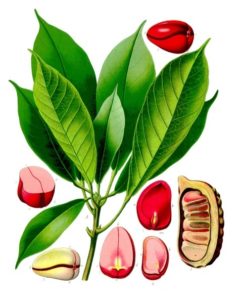Here is a short work from the one and only Ally. She put this together a while back for a project and we thought that some interested soul out there would enjoy it. Here you go…
Short:
Did you know Coca-cola was originally made from a nut? In fact, all forms of cola originate from the Kola nut! Kola nuts grow on kola trees, native to Africa. The nuts are in a thick husk which must be soaked and removed. Kola nuts are highly caffeinated and provide the sweet flavor and dark color commonly associated with soda. Kola has been consumed by Africans for years due to its stimulant like effect and medicinal uses. The nut can be chewed to treat mental and physical fatigue and ease hunger pangs. In 1886, an American pharmacist used kola extract to flavor the carbonated beverage known as Coca-cola. Although underutilized and no longer used in American sodas, the Kola nut still offers some extraordinary benefits.
Long:
The kola nut is a member of the Sterculiaceae family and has common names that include kolanut, cola nut, kola, or cola. The nut grows on understory evergreen trees ranging from 40-60 feet in height, leaves are ovoid in shape and 6-8 inches long. The tree produces flowers that are yellow/green or white with purple markings. The fruit on the tree are star shaped with green wrinkled pods containing the actual kola nut. The kola nut is native to tropical rainforests of West Africa and has been cultivated and traded for hundreds of years. The plant is culturally significant to many African tribes. Some communities consider the nut a symbol of love and friendship and use kola in rituals and ceremonies. Kola has been consumed by Africans for years due to its stimulant like effect and medicinal uses. The nut can be chewed to treat mental and physical fatigue and ease hunger pangs (Atawodi et al., 2007). In 1886, an American pharmacist used kola extract to flavor the carbonated beverage know as Coca-cola (Burdock et al., 2009). The nut’s production is largely consumed locally by Nigerians and imports and uses of kola nuts in America has started to decline.
Production:
Nigeria is responsible for 70% of the world’s kola nut production but in many regions, including the South Eastern states of Nigeria, there are no kola nut plantations or farms. Instead, kola production comes from Kola trees scattered within Cacao plantations and homesteads in this region that average 2-15 kola trees either planted in orchards or spread around their homes for their spiritual benefits. Harvest in Nigeria occurs twice a year during the months of May/June and November/December. The fruit are hand harvested by plucking. Some farmers harvest the fruit before full maturity to prevent attack by insect (Asogwa et al., 2012).
Processing:
Processing, storage, and preservation of kola nuts are challenging tasks for most farmers. Methods of processing the nuts are different for C. nitida and C. acuminata. Generally for both species, pods are cut open with a knife and the external husks are removed from the bean. The beans are then fermented (soaked in water) for a variable amount of time, variable from region to region. After the beans soak in water they are washed to remove the skins, dried (in baskets or directly on ground), then put in a basket and covered to cure. Specific leaves that vary depending on region and species of kola nut are used to cover layers of the nuts and then covered with thin transparent polythene sheets. Weekly inspections of the covered kola nuts and changing of dried leaves is vital to kola processing quality control to remove pests. Some farmers use lime or organochlorine to prevent insect attack of the freshly harvested nuts. Whole nuts can be stored for over 14 months with proper processing (Asogwa et al., 2012).
Marketing:
Kola nut is produced in Southern Nigeria and marketed and consumed largely in Northern Nigeria. Most farmers sell their product in small quantities such as bowls or cups. No standard grading or local pricing of the nuts results in pricing based on knowledge of market selling prices and bargaining power. White and bright colored nuts are priced at more premium rates than red and dull nuts. Cola nitida is the only kola nut approved for inter-regional and international trade (Asogwa et al., 2012). Large quantities of these nuts are exported to other African countries.
Economic and nutritional status of kola nut:
Kola nuts have been utilized medicinally by Africans for centuries. Kola nuts contain alkaloids such as caffeine and theobromine. Research has recently found that caffeine content of the nut is associated with environmental factors of the plant (Oladokun, 1989). Current economic statistics report that Nigeria produces 80% of kola nuts worldwide. Nigeria produces 200,000 metrics tons of fresh kola nuts annually but most production is consumed locally.
Work Cited:
Atawodi, S.E., B. Pfundstein, R. Haubner, B. Spiegelhalder, H. Bartsch, and R. Owen. 2007. Content of polyphenolic compounds in the Nigerian stimulants Cola nitida ssp. alba, Cola nitida ssp. rubra A. Chev, and Cola acuminata Schott & Endl and their antioxidant capacity. J. Agric. Food Chem. 55:9824-9828.
Asogwa, E.U., A.H. Otuonye, K.A. Oluyole, T.C.N. Ndubuaku, and E.O. Uwagboe. 2012. Kolanut production, processing and marketing in the South Eastern states of Nigeria. Am-Euras. J. Agric. Environ. Sci. 12(4):463-468 (abstr.).
Asogwa, E.U., A.R. Adedeji, A.V. Oyedokun, A.H. Otuonye, F.C. Mokwunye, and A.E. Agbongiarhuoyi. 2012. Strategies for improving production and storage of kolanuts in Nigeria. Am-Euras. J. Agric. Environ. Sci. 12(1):37-43 (abstr.).
